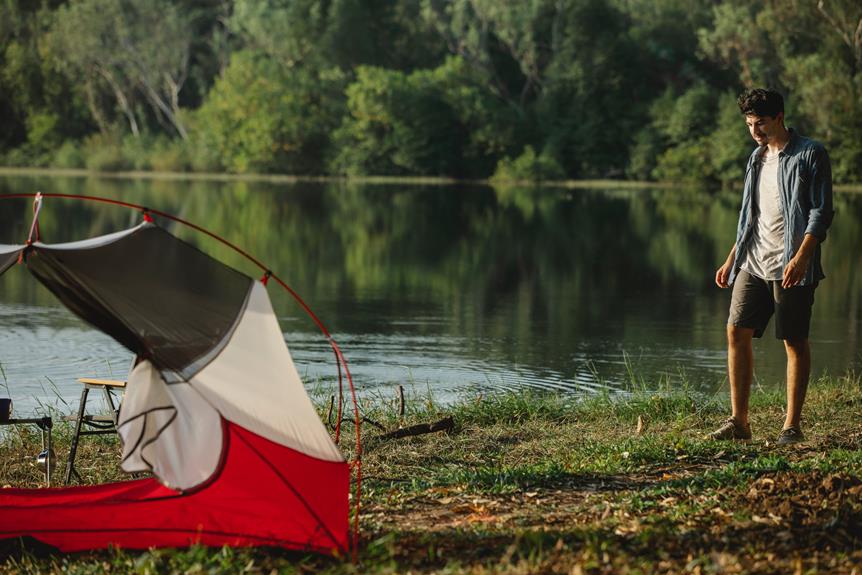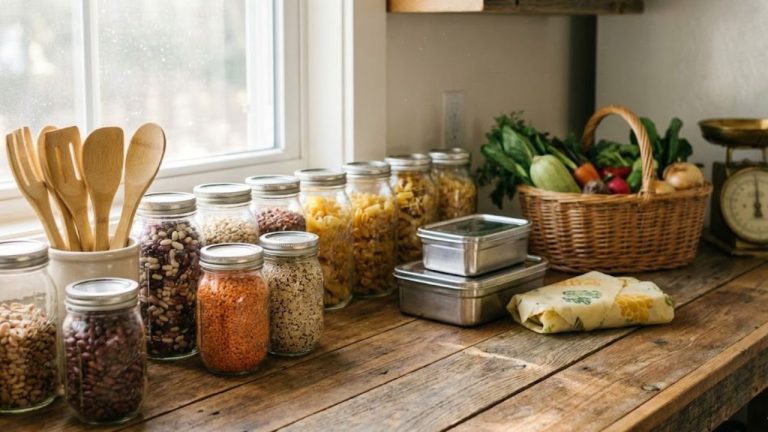Welcome to our guide on creating an eco-friendly home landscape! We’ll show you how to make a positive impact on the environment right in your own backyard.
Together, let’s transform our outdoor spaces into havens of sustainability. By choosing native plants, harvesting rainwater, composting, and utilizing organic pest control, we can create a harmonious balance between nature and our homes.
With efficient irrigation systems, permeable surfaces, and energy-efficient outdoor lighting, we’ll not only reduce our carbon footprint but also provide a welcoming habitat for wildlife.
Let’s embark on this journey of eco-friendly landscaping and make a difference together.
Native Plants
We always prioritize using a variety of native plants in our home landscape to maximize ecological benefits. Native plants are species that naturally occur in our region and have adapted to the local climate, soil conditions, and wildlife. By incorporating native plants into our garden, we can create a thriving ecosystem that supports local wildlife, conserves water, and reduces the need for pesticides and fertilizers.
Native plants are also well-suited for organic gardening practices, as they require less maintenance and are more resistant to pests and diseases. Additionally, native plants provide food and habitat for native insects, birds, and other wildlife, helping to restore biodiversity in our communities.
Rainwater Harvesting
To enhance sustainability and reduce water consumption, incorporating rainwater harvesting is a key strategy for creating an eco-friendly home landscape. One effective way to implement rainwater harvesting is by using a rain barrel.
These barrels collect rainwater from the roof through downspouts, storing it for later use in your garden or lawn. This simple method not only conserves water but also helps reduce runoff, erosion, and pollution caused by stormwater.
By utilizing rainwater, you can reduce your reliance on municipal water supplies, lower your water bills, and contribute to a more sustainable environment. Make sure to position your rain barrel near a downspout and use a screen to filter out debris.
Remember to check local regulations before installing rain barrels, as some areas may have specific guidelines and restrictions.
Composting and Mulching
Let’s talk about the benefits of composting and how to effectively mulch in our home landscapes. Composting is a great way to reduce waste and create nutrient-rich soil for our plants. Mulching, on the other hand, helps conserve water, suppress weeds, and improve soil health.
Benefits of Composting
Composting and mulching provide numerous benefits for an eco-friendly home landscape. Composting benefits not only the environment but also the overall health of your garden. By composting, you can reduce waste and create nutrient-rich soil that promotes plant growth.
The techniques involve collecting organic materials like food scraps, yard waste, and leaves, and allowing them to decompose naturally. This process not only reduces the amount of waste going to landfills but also helps to improve soil structure and fertility.
Composting also helps to retain moisture in the soil, reducing the need for excessive watering. It also encourages the growth of beneficial microorganisms that aid in plant health.
Mulching Techniques Explained
How can we effectively utilize mulching techniques to enhance our eco-friendly home landscape?
Mulching is a vital practice in organic gardening, offering a multitude of benefits for both plants and the environment. When we apply mulch to our garden beds, we provide a protective layer that retains moisture, suppresses weeds, and regulates soil temperature. This organic matter also breaks down over time, enriching the soil with essential nutrients.
To get started with mulching, first, remove any weeds or grass from the area. Next, spread a layer of organic material such as straw, wood chips, or compost around your plants, making sure to leave a small space around the stems. Aim for a thickness of around 2-4 inches, ensuring proper insulation and weed prevention.
Organic Pest Control
When it comes to creating an eco-friendly home landscape, organic pest control is an essential aspect. Natural pest deterrents are a great alternative to harmful chemical pesticides, as they’re safer for the environment, pets, and humans.
Natural Pest Deterrents
We rely on natural pest deterrents for organic pest control in our eco-friendly home landscape. Using natural pest control methods not only helps to protect our environment but also promotes a healthier and safer living space for our family.
There are several eco-friendly pest management techniques that we can implement in our home garden. One effective method is companion planting, where we strategically plant certain plants that naturally repel pests next to vulnerable crops. For example, planting marigolds alongside vegetables can deter pests like aphids and nematodes.
Another natural pest deterrent is the use of organic sprays made from ingredients like neem oil or garlic, which can effectively repel insects without harming beneficial organisms.
Harmful Chemical Alternatives
One alternative to harmful chemicals for organic pest control in our eco-friendly home landscape is the use of beneficial insects. These insects, such as ladybugs and lacewings, can help control pests naturally, without the need for chemical pesticides.
Here are four ways to incorporate beneficial insects into your sustainable gardening practices:
- Attract them with the right plants: Plant flowers like marigolds, daisies, and sunflowers, which provide nectar and pollen for beneficial insects.
- Create habitats: Build small shelters and provide water sources for beneficial insects to thrive in your garden.
- Avoid pesticide use: Harmful chemicals can kill beneficial insects, so opt for organic pest control methods instead.
- Use organic fertilizers: Chemical fertilizers can harm beneficial insects, so choose organic options that promote healthy soil and biodiversity.
Efficient Irrigation Systems
To ensure water conservation, it’s crucial for homeowners to utilize efficient irrigation systems. One effective method is drip irrigation, which delivers water directly to the plant’s root zone, reducing water waste through evaporation and runoff.
Drip irrigation systems consist of small tubes or emitters that release water slowly and evenly, promoting healthier plant growth while using less water. These systems can be easily installed in gardens, flower beds, and even on potted plants.
Additionally, they can be automated with timers or sensors, ensuring precise watering schedules based on the plant’s needs and weather conditions. By using drip irrigation, homeowners can significantly reduce their water consumption, conserve resources, and create a more eco-friendly home landscape.
Permeable Surfaces
Permeable surfaces offer several benefits, including effective rainwater absorption and runoff minimization. By incorporating these surfaces into your home landscape, you can create an eco-friendly environment that promotes water conservation and reduces pollution.
Here are four ways to incorporate permeable surfaces into your landscape:
- Install a rain garden: A rain garden is a depressed area in your yard that captures and absorbs rainwater. By planting native, water-loving plants in the rain garden, you can help filter the water and allow it to slowly percolate into the ground.
- Consider a green roof: A green roof is a roof covered with vegetation. It not only adds beauty to your home but also helps absorb rainwater and reduce stormwater runoff.
- Use permeable pavers: Instead of traditional concrete or asphalt, opt for permeable pavers for your driveways, walkways, and patios. These pavers have gaps that allow water to filter through, reducing runoff and replenishing groundwater.
- Create a gravel or mulch pathway: By using gravel or mulch instead of concrete for pathways, you can allow rainwater to seep into the ground rather than running off.
Incorporating permeable surfaces into your home landscape is a practical and environmentally friendly way to minimize runoff and promote water conservation.
Wildlife Habitat Creation
Creating a wildlife habitat within our eco-friendly home landscape is essential for promoting biodiversity and providing a safe haven for native species. By attracting pollinators and creating bird-friendly spaces, we can play a crucial role in supporting our local ecosystem.
To attract pollinators such as bees and butterflies, we can plant native flowering plants that provide nectar and pollen. These plants not only add beauty to our landscape but also help in the reproduction of many plant species.
Additionally, creating bird-friendly spaces involves providing food, water, and shelter for our feathered friends. Bird feeders, bird baths, and native trees and shrubs can all contribute to a welcoming habitat for birds.
Energy-Efficient Outdoor Lighting
Installing energy-efficient outdoor lighting is a key step in creating an eco-friendly home landscape. Not only does it reduce energy consumption and lower electricity bills, but it also minimizes the carbon footprint.
Here are four ways to incorporate energy-efficient outdoor lighting into your landscape:
- Solar Powered Fixtures: Opt for solar powered lights that harness the sun’s energy during the day and illuminate your outdoor spaces at night. These fixtures are easy to install and require no wiring or electricity.
- Motion Sensor Lighting: Use motion sensor lights to provide illumination only when needed. These lights automatically turn on when they detect movement and turn off after a certain period of inactivity, saving energy and reducing light pollution.
- LED Bulbs: Replace traditional incandescent bulbs with energy-efficient LED bulbs. LED lights consume less energy and have a longer lifespan, making them a cost-effective choice for outdoor lighting.
- Timer Controls: Install timer controls to set specific schedules for your outdoor lighting. This ensures that lights are only turned on during specific hours, reducing unnecessary energy consumption.
Conclusion
Creating an eco-friendly home landscape isn’t only beneficial for the environment but also for our own well-being.
By incorporating native plants, rainwater harvesting, composting, organic pest control, efficient irrigation systems, permeable surfaces, wildlife habitat creation, and energy-efficient outdoor lighting, we can reduce our carbon footprint and create a sustainable and beautiful outdoor space.
Embracing these practices won’t only contribute to a healthier planet but also inspire others to join in the movement towards a greener future.




